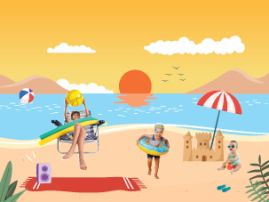Living in Townsville
Providing a laid-back tropical lifestyle that is complemented by capital city comforts, no other Australian city boasts the resilience, diversity, lifestyle, and economic potential that the Townsville North Queensland Region enjoys.
Known as the Second Capital of Queensland, with a population of approximately 198,143 people, Townsville offers a dynamic lifestyle coupled with strong economic prosperity. Townsville is a thriving city, with access to a variety of world class education facilities, market leading health care, affordable housing, unique retailing, spectacular events and entertainment, dining precincts and a wide range of outdoor recreation options. With over 300 days of sunshine each year, Townsville’s lifestyle is second to none.
Make the move to Townsville, North Queensland
Check out what Townsville has to offer!
Our Population
Outside the southeast corner, Townsville is the largest city in regional Queensland.
- Our current official population count is 201,443 persons (ABS 3218.0 Regional Population Growth, Australia).
- It is estimated that by 2046, we will have a population of approximately 264,899 people (Queensland Government Population Projections, 2023).
Our Economy
Townsville has a diverse economy, significant industries include retail trade, health and education services, government administration and defence, construction, mining, manufacturing, and property and business services.
Together, Queensland Rail and the Port of Townsville provide a transport hub for the region’s mining and agricultural industries, as well as for locally-based Xstrata Copper Refinery, Sun Metals Zinc Refinery and the Queensland Sugar Corporation Distribution Centre.
Our city is a major service centre, and the main centre for government administration outside Brisbane. Regional health services are provided by the Townsville University Hospital. There are a number of research institutions such as James Cook University, the Australian Institute of Marine Science, the Great Barrier Reef Marine Park Authority, Department of Agriculture, Fisheries and Forestry and the CSIRO. Our large Australian Defence Force community, due to our army and air force bases, also influences the local economy.
To support the region's growth, we’ve developed a strategy centred on thoughtful, incremental expansion through the Local Housing Action Plan. This plan serves as our city’s comprehensive roadmap for fostering a vibrant, inclusive, and future-ready urban environment.
Current job vacancies at Council can be located on the Current Job Vacancies webpage.
Our Geography
Townsville is located approximately halfway between the tip of Cape York and Brisbane. The Ross River flows from the foothills of the Hervey and Mount Stuart ranges to its outlet in Cleveland Bay, where the CBD’s skyline is dominated by the distinctive Castle Hill. Magnetic Island lies just eight kilometres offshore and is accessible via a 20-minute ferry trip. From the top to the bottom of our Local Government Area, our eastern coast is lined by beautiful Queensland beaches.
Our local government area covers 3,736 square kilometres (0.2% of the total area of the State of Queensland).
Our Environment
Townsville lies in the Burdekin Dry Tropics Region, which covers approximately 95,000 square kilometres and includes Bowen, Ayr and Charters Towers.
In the low-lying coastal plain, there are a number of rivers, creeks and freshwater wetlands. Hills and mountains rise out of the coastal plain, creating distinctive landmarks such as Castle Hill. The long coastline features beaches, mangrove estuaries, saltpans, and coastal swamps. These natural habitats support a wide range of flora and fauna including: 53 mammal species; a large number of reptiles and amphibians including land snakes, estuarine crocodiles, and a diverse range of lizard and frog species; and at least 365 bird species. Endangered, vulnerable and rare species are also found, including mahogany gliders, dugong, and cassowaries.
National parks and other reserves include Magnetic Island, Paluma Range, and Bowling Green Bay National Parks, and the Cape Pallarenda and Townsville Town Common Conservation Parks. Our region is partly within and adjoins the Great Barrier Reef World Heritage Area, the Great Barrier Reef Marine Park, and the Queensland State Marine Park.





